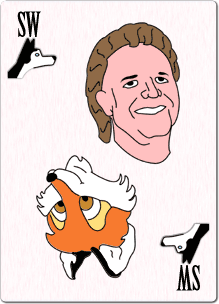 |
   an interview conducted by Phil Geusz Questions ©2008 Phil Geusz; answers ©2008 Eddy & Susman |
||
|
|
|||
 |
   an interview conducted by Phil Geusz Questions ©2008 Phil Geusz; answers ©2008 Eddy & Susman |
||
|
|
|||
Jeff Eddy and Tim Susman are the founders of Sofawolf Press, one of furrydom’s most prominent publishing houses and longest-lived institutions, period. It is distinguished by the consistent excellence it achieves in terms of content, artwork, and sheer professionalism. Today Sofawolf stands as one of the proudest icons of the fandom, one of the institutions of which we can be proudest.
In addition to their regular-as-clockwork publishing schedule, Tim and Jeff attend (and maintain a highly professional retail presence at!) a variety of conventions, including Further Confusion, WonderCon, AnthroCon, Comic-Con International, and Midwest Furfest. This year they’ll be at Rocky Mountain Fur Con, as well. Finally, Sofawolf’s founders will be attending Eurofurence 2008, but only as guests, not in a professional capacity.
With that level of activity, it’s clear that keeping up with Tim and Jeff is (or at least, should be) an Olympic event… but Phil Geusz managed to do precisely that! So now, Anthro is proud to present Mr. Geusz’ interview with…
Jeff Eddy and Tim Susman!
|
Geusz: |
To begin with, could you give us some background on yourselves? |
|
| Eddy: |
I’ve been writing on and off for many years, but never quite got serious about it. Instead, I focused on reading and commenting on the work of others. This led me to the world of publishing, and this, in turn, logically brought me to where I am today, to the point where I no longer have the time to read or edit anything anymore. Instead, I manage: Money, schedules, projects, people, and sales. The rest of the time, I do enterprise software support (to pay the rest of the bills), attempt to train our two huskies (to keep them from eating the house), and pass the long Minnesota winters with my partner Alopex. |
|
| Susman: |
I earned degrees in engineering and management from the University of Pennsylvania, then enrolled in graduate school at the University of Minnesota to study Zoology. With respect to the furry fandom, I’ve had stories published in several venues—Yarf!, Mythagoras, Anthrolations, Amazon Shorts, and a couple convention books. I also started a novel that never got finished, but since that’s the project that brought Jeff and me together, I don’t think anybody minds. |
|
|
Geusz: |
When and how did you guys first discover the furry fandom? Were you writers before then? |
|
| Eddy: |
Tim is the writer—I don’t have the attention span. As for discovering the fandom, it was typical: I got a computer and an internet account way back in the early ’90s, found some stuff online, overcame the initial terror, and here I still am. |
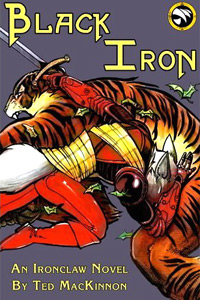 |
| Susman: |
Jeff is being modest. He’s written his share of stories, some of which you can find in early Sofawolf publications—and not just because he’s the editor-in-chief. |
|
| Eddy: |
Yeah, I’ve written stuff… but I don’t know if I consider myself a ‘writer’. |
|
| Susman: |
As for me: Like I said, I’ve been a writer for a long time, since back in college. I’ve also been making up stories ever since I could remember. The first thing I had ‘published’ was a piece in my college science fiction magazine about an alien who’d been exiled to Earth and disguised as a human—and his actual form was something furry. It wasn’t until about five years later that I discovered the furry fandom, through the internet and a usenet group dedicated to fans of Tiny Toon Adventures. Like Jeff, I survived the first contact and have remained entrenched ever since. |
|
|
Geusz: |
How did you come to found a publishing company? |
|
| Eddy: |
Oh, I found one of Tim’s writing projects online and really liked it. We started chatting and at some point the subject came up of the lack of places to publish short stories in the fandom. At the time there was really just Yarf!, which was irregular at best, and PawPrints, which was aggressively G-rated. We wanted something with a little more edge. Tim said something like “we should start a fanzine” and it sounded like a good idea at the time. |
|
| Susman: |
I’d had a piece published in Yarf! Through various miscommunications, I never got my complimentary copies, so I wasn’t excited about approaching them again. I’d written Many Years From Now, which Jeff thought should be published somewhere, but it was too long for most of the venues we knew about and weren’t that excited about anyway. In the course of the discussions, we found that we were both lamenting the lack of a consistent, quality venue for all the furry fiction we knew was out there. Jeff had the energy and ambition to get it started, and I was willing to stick around and help for moral support. |
|
|
Geusz: |
Your company has a great name! How did you come up with that? |
|
| Eddy: |
Blame my Siberian Husky, Rio. She used to like to perch on the back of my sofa when she was a puppy, paws crossed, looking very regal and in command of the situation. A friend gave her the nickname “Sofa Wolf”, and later it seemed like a great name for the Press. Things like this, you know, from the outside you think people actually thought about them; but so often it’s a one-second decision… |
|
|
Geusz: |
Tell us about your first publication, and what it was like to bring it to market. |
|
| Eddy: |
Now, this we thought about for a while. We wanted the name of the publication (technically a magazine, as we always paid for submissions) to reflect something about the theme of the stories, but there really was no hard theme. We wanted most of the stuff to be character-based stories, which are kind of about relationships of various types. We took ‘Anthro’ and ‘Relations’ and made Anthrolations. It never entirely sat well with me, but barring anything else we went with it. |
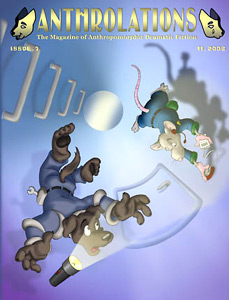 |
| Susman: |
The title was something that’s sort of created its own brand in time. As for the magazine itself, I think it’s a testament to the creativity in the furry fandom that we were able to get a high-quality magazine together just from people we knew and with a brief call for submissions. For a first effort, it went off remarkably well. There were a few missteps in production, but we were happy to have created something out of the gate that really represented the level of quality we were hoping for. |
|
| Eddy: |
We were doing something that on one hand lots of people had done before in the fandom—start a fanzine—but on the other hand, we were trying to do it much differently. We needed to let the fans know we were here, and had the quality of content they were looking for, but also let the artists know we were professionals who paid well and on time, and would be around for a while. |
|
| Susman: |
The quality of the publication itself is only half of what’s special about Sofawolf. Jeff is the other half. He consistently keeps us professional behind the scenes, dealing with artists and writers, paying on time and publishing on time. We’ve had artists and authors approach us to say they want to work with us—that’s as special to us as people who tell us they’ll always come to our table because our products are consistently good. And Jeff insisted on that from day one. We’d both heard about many less well-run furry publications in the past. It’s a small fandom and word gets around. We promised that whatever else we did, we wouldn’t be one of those. |
|
|
Geusz: |
Were there any unexpected challenges? |
|
| Eddy: |
None of the things I just mentioned were really ‘unexpected’, as I kind of knew the road before I set out on it. The unexpected part was probably all the other stuff I needed to learn: Tax and publishing law, accounting, finance, distribution, marketing, advertising, etc… Publishers fall into an interesting grey area, as we make a physical good from nothing, essentially. It makes accounting a challenge, and there aren’t a lot of resources for small businesses doing this. |
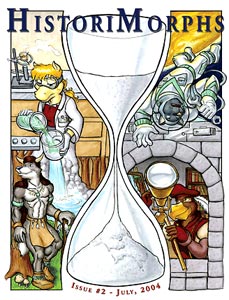 |
| Susman: |
As Jeff says, there wasn’t much unexpected. The biggest challenge was getting people to notice the stories we were telling. I think we pretty much cleaned out our circle of friends with that first issue. In fact, Many Years From Now ended up being too long to include entirely in the first issue, but we decided to run half of it and commit to doing a second one. I like to think that showed people we were serious about this whole small press thing, but I’m not sure that enough people noticed for it to matter. |
|
|
Geusz: |
As a furry author myself, I well understand that the bulk of the fandom is more interested in visual art than literary stuff. Are you ever as envious of the artists as I am? |
|
| Susman: |
Somewhat. That’s why I started learning to draw, so I could illustrate my own stories and maybe get a little of that respect. But on the other hand, the focus on art meant that there was a lot of room for Sofawolf to step in and fill the literary niche. |
|
| Eddy: |
Oh sure. You can’t grab a table in the Artists’ Alley at cons and do little books for $10 a pop like they can do badges. But, I love all the art we have in the fandom. I don’t think enough people appreciate the massive amount of talent this fandom has for creating things. A lot of the other fandoms are based around a mainstream media element—someone else’s creation. We’ve always had to make our own fandom from scratch, more or less. Much of the art I see 14 year old girls doodling in the Artists’ Alley blows the doors off what you see outside. |
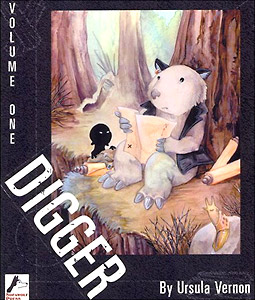 |
| Susman: |
Absolutely! As I mentioned above, the level of creativity in this fandom is astounding. And even though there are some artists who just cater to the fandom because there’s money to be made, the vast majority really love what they’re doing and love the fans too |
|
|
Geusz: |
I note that you seem to have developed quite a fertile partnership with noted artist Ursula Vernon? |
|
| Eddy: |
Heh! I adore Ursula. Apart from being a seriously talented artist and writer (and sculptor, etc), she is delightfully pragmatic and just fun to be around. It is a great pleasure to all of us to have been able to be some small part of her continued success. |
|
| Susman: |
I can’t add anything to that. She’s a terrific person and immensely talented. |
|
|
Geusz: |
I’ve always felt that your furry-anthology Best in Show marked a major turning point in the literary history of our fandom. Not only was it the fandom’s first serious attempt (to my knowledge, at least) along these lines, but the book was reviewed by serious SF/F critics and the authors’ names were listed in Locus magazine, the professional journal of the SF/F publishing world. How did this collection come to be? I know that noted furry literary critic Fred Patten had a role; was it his idea entirely? |
|
| Eddy: |
It was Fred’s idea, yeah, and he did most of the legwork on the project. That was a big part in making it see the light of day. Tim picked up a good chunk of the rest. It was our first book and it was a bigger task than anything we had attempted before. |
|
| Susman: |
Actually, Breaking The Ice was our first book, but this was something way more complicated and huge than anything we’d done. Fred had approached us with the thought that he wanted to highlight the best stories in his vast collection of fanzines. We thought that the idea was a great one and fit with our goals. He sent us a list of nearly a hundred stories, which we pored over and whittled down to twenty-six, adding a couple that we liked that he wasn’t aware of (it’s rare to find stories that Fred hadn’t heard of). We contacted all the authors and got permission, worked out the royalty payments, and got the book published. Ursula did the cover—I think that was our first project with her. |
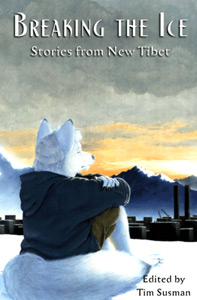 |
| Eddy: |
Ah, right—I overlooked Breaking the Ice, I think because it came together so easily, comparatively. Yeah, Ursula did the cover, and this was when she was still living in Minneapolis. We met with her to sign the contracts at a little Tibetan restaurant and had Yak meatballs while watching the snow gently fall outside (it was late March). Sort of set the tone for our future, somewhat surreal, interactions with Ursula, really. |
|
|
Geusz: |
Best in Show sold out more than one printing, and was picked up for a short time by another publisher, as well. |
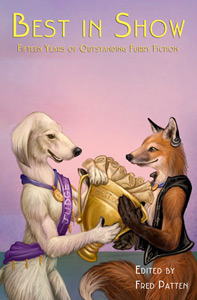 |
| Susman: |
Right. Fred, through his connections, got the book picked up by iBooks, where it was published as Furry! until Byron Preiss’s tragic death, which resulted in iBooks declaring bankruptcy. All of iBooks’ properties are tied up in court right now to determine their status. |
|
|
Geusz: |
Will it ever be made available for sale again? |
|
| Eddy: |
Perhaps. Best in Show was big and had a lot of pages for a trade paperback, not to mention a lot of people involved in the process. Ultimately it was a very expensive proposition to produce and was more of a salute to both the fandom and to Fred than a project that would ever really pay off in dividends. It may resurface, but we have to see what happens in court. |
|
|
Geusz: |
No other furry publisher’s imprimatur seems to carry even a fraction of Sofawolf’s weight in the larger world of the written word. How did you ever gain so much respect so quickly? |
|
| Eddy: |
Doesn’t feel quickly… We’re entering our ninth year of business now, which is probably longer than any other business entity in the fandom, that I am aware of. I think just being around and obviously still being in the ascendant has a lot to do with it. We’ve always looked and acted bigger than we actually are, and hold ourselves to a quality level that outstrips even a lot of what you see on store shelves. |
|
| Susman: |
I sort of covered this earlier. Besides Jeff’s very valid point about consistency and quality, we have always maintained a professional attitude in our dealings with our contributors and our consumers. We never forget that it’s our contributors who help us create the product we love, and our fans who enable us to keep the business going. As Jeff said, it doesn’t seem quick to us, but I think it seems that way to other people who’ve only known us for the last four or five years, when we already had a big stable of products. |
|
|
Geusz: |
Anthrolations has been through eight issues now, making it one of the longest-running publications in the fandom. What does the future hold for it? Also, it’s my understanding that New Fables is meant to showcase furry work in a format that might appeal to readers who aren’t necessarily fur-fans. How’s that working out? |
|
| Eddy: |
Anthrolations is somewhat of a problem child. We had planned on no longer working on it, but got sufficient outcry to keep it around. The trouble is that it takes a lot of time to put together and a lot of money to purchase all the rights; but the market for short-story magazines is not really sufficient to ultimately generate much revenue. I hate to sound corporate, but we have to juggle time versus profit in order to keep moving forward. |
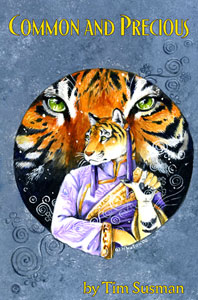 |
| Susman: |
New Fables has gotten a lot of positive reviews from people who’ve seen it. I’m still trying to reach out to larger communities for contributions. Volume 2 features some work by people the fandom may not be familiar with; the hope is that those people will help introduce a wider audience to the books. I’m also working on hooking up with more small press resources and some marketing resources. I’m very happy with the quality of the volumes we’ve got so far, and I think they both showcase a ‘literary’ side of the fandom. |
|
|
Geusz: |
Are there any more New Tibet books in the works? |
|
| Susman: |
There are none with a planned production date right now. I’m writing a couple New Tibet stories, and there’s always the chance that a few other people will complete some stories and we’ll get a collection together. |
|
|
Geusz: |
How did your Heat series come into being? |
|
| Eddy: |
There is no way you can take a look at the fandom and not see the financial opportunities presented by adult material. But beyond that, it is something that everyone on the staff enjoys to some level or other, so at some point the question of “Why aren’t we doing this?” came up. Heat (and I love that name, by the way—I was glad we could be the first to use it) was the logical extension of Sofawolf seeing a market that needed its touch and then applying it. Under Alopex’s direction, it has become just what I hoped it would: sexy, flashy, trendy, and the highest quality. |
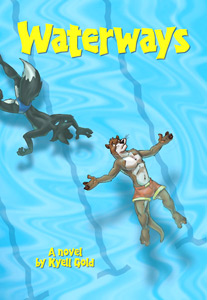 |
|
Geusz: |
Some furs are rather sensitive about the subject of sexually-explicit artwork in the fandom. Does this sensitivity carry over into the printed word? |
|
| Susman: |
Of course that sensitivity does carry over to the written word, but we treat the material like grown-ups. We understand that there are people who don’t want to see it. We label it clearly and we make sure that the people who want it can get it, and the people who don’t, don’t have to. There haven’t been very many problems at all. |
|
| Eddy: |
Ultimately, I think there is an unhealthy dose of paranoia around the whole ‘adult material in the fandom’ thing. I suspect it is probably the most adult thing to go across the equipment at our printers, and I would love to hear what they think about it. I’ve had an amused grin or two when discussing the title with the production staff or the folks who do the packing and shipping, but their comments have mostly all been about the amazing quality of the art and layout. Obviously there are topics that a smart publisher stays away from, but Heat is ultimately not all that ‘shocking’ to people outside the fandom. My sister loves it, but then like me she was always a little odd. Sorry, sis… |
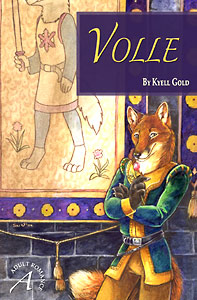 |
|
Geusz: |
Making ends meet has to be one of the toughest challenges there is for a small-press outfit. Even the big boys are having a rough go of it lately, as fewer and fewer books are sold. Does Sofawolf turn a profit? Or is it mainly a labor of love? If the latter, then how on earth do you two find enough time in your lives to publish so much material? |
|
| Eddy: |
We turn a profit in that I no longer have to sink money into the press on a regular basis to keep it going. We now have enough money left over at the end of the year to put into bigger and better projects and marketing the following year, but if I had to support even just myself on the profits it would never, never work. To get to that level would take a major expansion of our markets, and I am not sure we’d survive it even if I wanted to. |
|
| Susman: |
The fact is that we both love what we do, so we make the time for it. We both have day jobs, but they’re mainly ways that we pay for the things we love. As Jeff remarked, the press is right about at the level where we can manage it while only being a little bit overwhelmed, so it feels like we’re in a good place, and the fact that it pays for itself now takes the financial pressure off. |
|
| Eddy: |
So it is both, really. We turn a profit, put it all back into the business, and work our tails off in the name of building something wonderful. It’s not all fun and schmoozing, and it’s not all lugging boxes around and doing accounting, but it is a good mix of both. We find enough time by leaning on a lot of other good people who help out with bits and parts, and by not having any social life to speak of. |
|
|
Geusz: |
What’s the most fun you ever had publishing a book or story? |
|
| Eddy: |
I can’t narrow anything down to a specific publication, but the most fun I’ve had was Comic-Con International 2006, when Ursula was nominated for the Will Eisner Comics Industry Award for ‘Talent Deserving of Wider Recognition’. We sat with her at the award ceremony (she didn’t win), then took her out on the town, bought her flowers. It was wonderful. |
|
| Susman: |
I loved that Comic-Con occasion. Probably that would rank up on my list as well. In terms of just the adventure of publishing something, I think the first New Tibet collection was my favorite, just because of the excitement of putting a book together for the first time and the enthusiasm of all the authors, seeing the art come together and the finished product. |
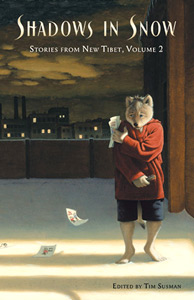 |
| Eddy: |
But there are the little things too: dinners out with a bunch of contributors, the pride at seeing a project come out the way you wanted it to, watching a marketing plan take shape, etc… I think if there wasn’t some fun in every bit of it, I’d have gotten bored and moved on to other things by now. |
|
| Susman: |
Having people come up and tell you that they’ll look at anything you put out; getting e-mails from people who loved Heat or one of the New Tibet books; talking to authors and artists who are thrilled not only just to be in print, but at the quality of the publication; dinners and planning meetings and layout and editing; and, of course, writing. I love it all. |
|
|
Geusz: |
Any horror tales from the slushpile you’d care to share? |
|
| Eddy: |
Oh, nothing outstanding. The biggest horrors we get in the Anthrolations slushpile are… horror, actually. Somehow we’ve gotten on a list somewhere that has us as a horror market, or maybe to the mainstream anything that includes anthropomorphic animals must mean werewolves, or something. I dunno. Sure there’s bad writing, but I see that every day passing for journalism in some of the biggest publications in this country, so it all kind of pales I think. |
|
| Susman: |
There are horrors in every slushpile, but at least with New Fables I’ve been very lucky to be getting good stories. The hard part has not been reading them, but writing thoughtful rejections of good material that just wasn’t quite right for one reason or another. |
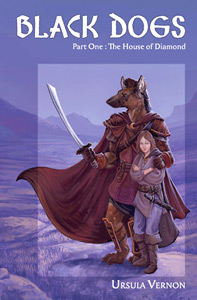 |
|
Geusz: |
There’s been a lot of discussion among furry authors about whether or not our stories constitute a ‘genre’ or not. Your thoughts? |
|
| Susman: |
My partner calls it a meta-genre, because it’s more a way of telling a story than a type of story. Personally, despite my biology background, I sometimes get tired of people arguing over labels. Does it matter whether furry is a genre or not? We know a furry story when we see it. |
|
| Eddy: |
Since all of our stories can exist in any other already established Genre (romance, fantasy, detective noir, etc), it’s really a loose union of other Genres held together by an arbitrary characteristic. You could just as well build a fandom around stories that take place in Belgrade, Serbia for example. So, yeah, I guess Meta-Genre would be a good description. |
|
|
Geusz: |
And, finally: What do you think the future holds for furry fiction? Can it ever achieve full mainstream acceptance, say on a par with science fiction? |
|
| Eddy: |
I think that is the wrong bar to be shooting for, in a way. I think science fiction only has mainstream acceptance when it lowers itself to the lowest common denominator. The various recent Star Trek franchises were ultimately little more than episodic TV dramas with science fiction trappings—safe and predictable. The truly revolutionary series like Babylon 5, Firefly, and Farscape would never have thrived on the major networks, and ultimately were probably better off being big fish in smaller ponds. |
|
| Susman: |
Furry is more or less a subset of science fiction, which I don’t think has full mainstream acceptance anyway. However, awareness of furry is certainly growing in the mainstream, thanks to MTV, CSI, and other outlets. And as the fandom grows, awareness in the mainstream is only going to grow along with it. Awareness doesn’t imply acceptance, but at least it is the first step to tolerance. There’s certainly a level of bias in some industries against furry fiction—or rather, I should say, with some people in some industries—and the more people start to recognize that there is money to be made by publishing furry fiction (in whatever industry), the more will be published, and the more people will get used to seeing it. |
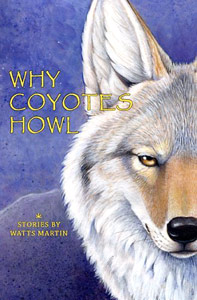 |
| Eddy: |
I think it is a mistake to look for acceptance, personally. Do what you do well, love doing it, and everything else will take care of itself. Sure, not everyone will see and appreciate what you do, but worrying about that is a road to madness. |
|
|
|